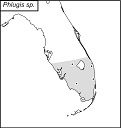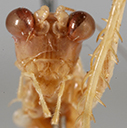




|

|

|

|
| map | male | male | male terminalia |

|

|

|

|
| female | female | ovipositor | Phlugis orioni male |

|

|

|

|
| male | female | juvenile | habitat |
| Alien origin and spread of this SINA species. |
Facts (as of 2017)
(images 2-8)
On 13 Jun 2013, an adult male Phlugis sp. was collected in Davie, FL, by sweeping the vegetation in a field across a street from a business that sold landscaping plants. The collector was Stephen Beidler, a Nursery Inspector employed by the Florida Division of Plant Industry. The specimen was preserved in alcohol and submitted for identification to Paul Skelley, Entomologist for FDACS-DPI. Recognizing it was something new, Skelley took it to T.J.Walker for help. Walker quickly recognized it as a member of the predatory genus Phlugis, which occurs natively in Central and South America. Learning that Phlugis was a diverse but little studied genus, Skelley contacted David Nickle, USDA, the orthopterist who had most recently published on the genus. The specimen was sent to Nickle in anticipation that he might be able to identify it to species.
In an email of 27 Sep 2017, Vince Golia, who lives in Palm Beach County reported to TJW that he had recently collected “a pair of Listroscelidinae” at light traps in his backyard at 9841 Scribner Lane, Wellington, FL. He had collected the female on 19 Jul 2017 at his black-light trap and the male on 12 Sep 2017 at his mercury vapor light. He indicated he had identified the specimens as belonging to the subfamily Listroscelidinae by comparing them to pictures he found on the Internet. [He attached an image of the one that led him to that conclusion.]
The image of the Phlugis orioni holotype is linked to the OSFO page that gives access to six images of each of the 17 Peruvian species of Phlugis described by Nickle in 2003. [To see these images go to OSFO’s Phlugis page and click on the name of any of the species described in 2003 by Nickle. You will be rewarded with a series of six thumbnails that expand with a click, in the same fashion as does the thumbnail above.]
Some speculations (as of 2017)
It seems unlikely that more than one species is involved. The males are similar but have yet to be compared by a specialist.
Phlugis spp., though small, are easily seen, active when disturbed, and striking in appearance. Being attracted to light makes it more likely they would have been detected decades ago had they long been a part of south Florida's insect fauna.
Current status (as of July 2020)
Starting in August 2019, more than 30 new images of Florida Phlugis have become available (see Images of Phlugis from iNaturalist). These images, from four widely spaced counties suggest that Florida’s “alien raptorial katydid” occupies suitable habitat throughout mainland south Florida (see map). Thus far we know that Florida’s Phlugis is widely present in south Florida’s marshes, but we know nothing of its role in that “everglades” ecosystem—what does it eat and what are its enemies? How do the sexes find each other, and what are its courtship and mating behaviors? Where are the eggs laid and how are they protected? All of these questions are likely to have unanticipated answers but the question of its diet seems of special importance. For example, in the present state of knowledge, one could hypothesize that it feeds mostly on mosquitoes that it captures with its raptorial forelegs and eats or releases depending on???
The last sentence in the above paragraph may have provoked a smile with the thought (“Wouldn’t that be convenient?”). Well, maybe, but no one has yet reported or documented what is caught and held for eating in those impressive catching devices on the front legs of the smallest juveniles or the largest adults. Someone with access to live specimens should study the feeding behavior of Florida Phlugis!
| References: | Nickle 2003. |
| Nomenclature: | OSF (Orthoptera Species File Online). |

|

|